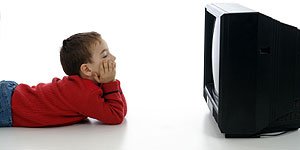A recent Australian study has validated what what mothers around the world have been saying for decades: ‘stop watching TV – go outside and play!’
 The study, published this week in the American Heart Association journal, Arteriosclerosis, Thrombosis, and Vascular Biology, found that the more time a child spends watching television, the narrower the arteries in their retina – an indication of future cardiovascular risk. The research has received a great deal of attention in the Australian press, with outlets such as the Telegraph, ABC, Canberra Times and News.com reporting on the study.
The study, published this week in the American Heart Association journal, Arteriosclerosis, Thrombosis, and Vascular Biology, found that the more time a child spends watching television, the narrower the arteries in their retina – an indication of future cardiovascular risk. The research has received a great deal of attention in the Australian press, with outlets such as the Telegraph, ABC, Canberra Times and News.com reporting on the study.
In response to the study’s publication our friends at the Australian Science Media Centre contacted experts to gain further insight into the study and its implications.
Feel free to use these quotes in your stories. If you would like more information or to speak to a local expert please contact the NZ SMC (smc@sciencemediacentre.co.nz).
———–
Dr Anu Anuradha is from the Cancer Prevention Research Centre in the School of Population Health at The University of Queensland
“This research conducted in 6-year old children in Sydney, Australia has shown that physical activity is beneficially associated with wider arterioles in the retina of the eye, while greater TV time is adversely associated with narrower arterioles. The eye is a unique site where the small blood vessels of the retina can be seen with the naked eye and photographed. These micro vessels represent those in the rest of the body. As a general rule, narrower arterioles and wider venules are adverse signs when one is examining the small blood vessels of the retina. Just because the arterioles are narrow now, that does not mean they will stay this way. Narrow arterioles may be a warning sign for heart disease as one gets older, but what remains to be seen is whether arterioles can be permanently changed with a long-term change in behaviour.
Research in this area is still in its very early stages, so a lot more work needs to be done to see if the long-term diameter of the blood vessels can be altered by exercise or by reducing TV time. TV time is the most frequently measured, but only one of several sedentary behaviours (all of which have low energy expenditure). Activity monitors that can accurately measure physical activity as well as sedentary behaviour are now available for use in research. This will overcome the inaccuracy of data obtained by questioning parents about the behaviour of their children. Moreover, like in adults, more research is needed to see if activities of lower intensity, for example, standing or fidgeting in front of a screen instead of sitting still is beneficial to children.
These findings are not surprising, as although this study is the first to be done in children, researchers have looked at the association of leisure-time physical activity and TV time in adults with the retinal blood vessels, among population groups in Australia and USA. In adults, both lower physical activity and greater TV time have been shown to be adversely associated with wider retinal venules but not the arterioles.”
———–
Professor Jo Salmon is from the School of Exercise & Nutrition Sciences at Deakin University, Victoria
Prof Salmon responds to some of our questions in relation to the study:
Are the study’s findings surprising?
“An increasing number of studies are finding associations between time spent sedentary, as well as TV viewing time with cardiometabolic health outcomes in children. EG, time spent sedentary has been shown to be adversely associated with insulin resistance and with likelihood of being obese, irrespective of physical activity levels. It would have been good if the study adjusted the TV viewing findings according to physical activity levels of the child, perhaps further research could examine this.”
Is watching TV worse than just sitting still?
“The evidence is still building regarding the health effects of overall sitting time. Most of the health evidence for children is in relation to TV viewing and there are possibly stronger effects from television viewing time because of snacking and unhealthy eating behaviours that occur in addition to the inactivity.”
What implications does the study have for future work in this research field and for Australian children?
“The health effects of time children spend sedentary may not be off-set by physical activity participation, more research is required to unpackage the independent health effects. This is important as we need to know if it is enough to just promote children’s physical activity for health or if we also need to target reductions in children’s sitting time.”